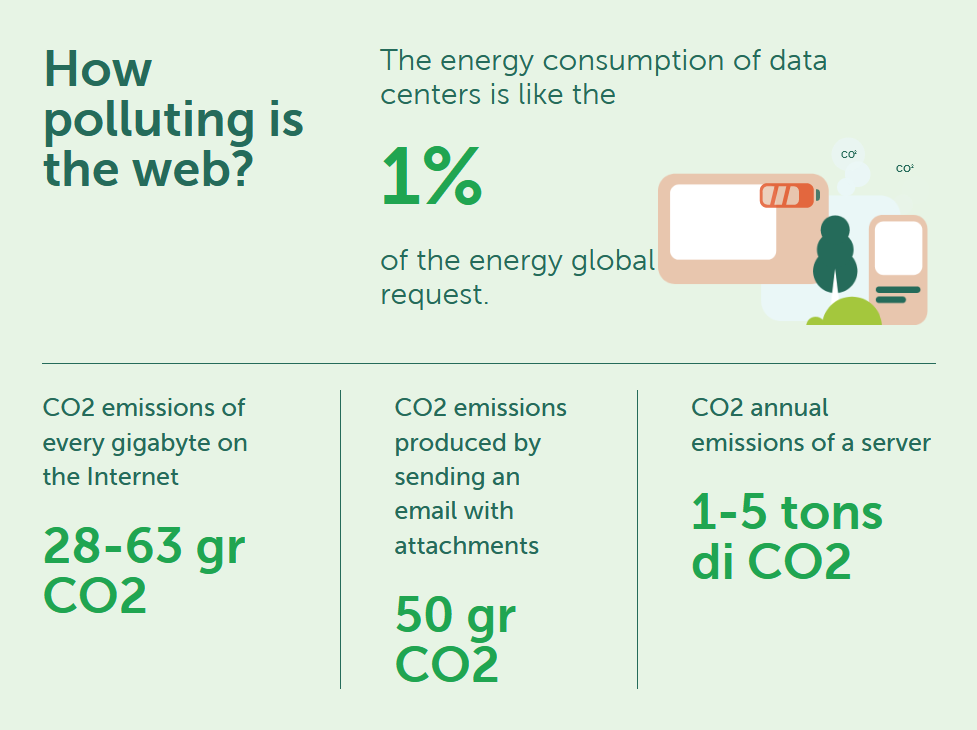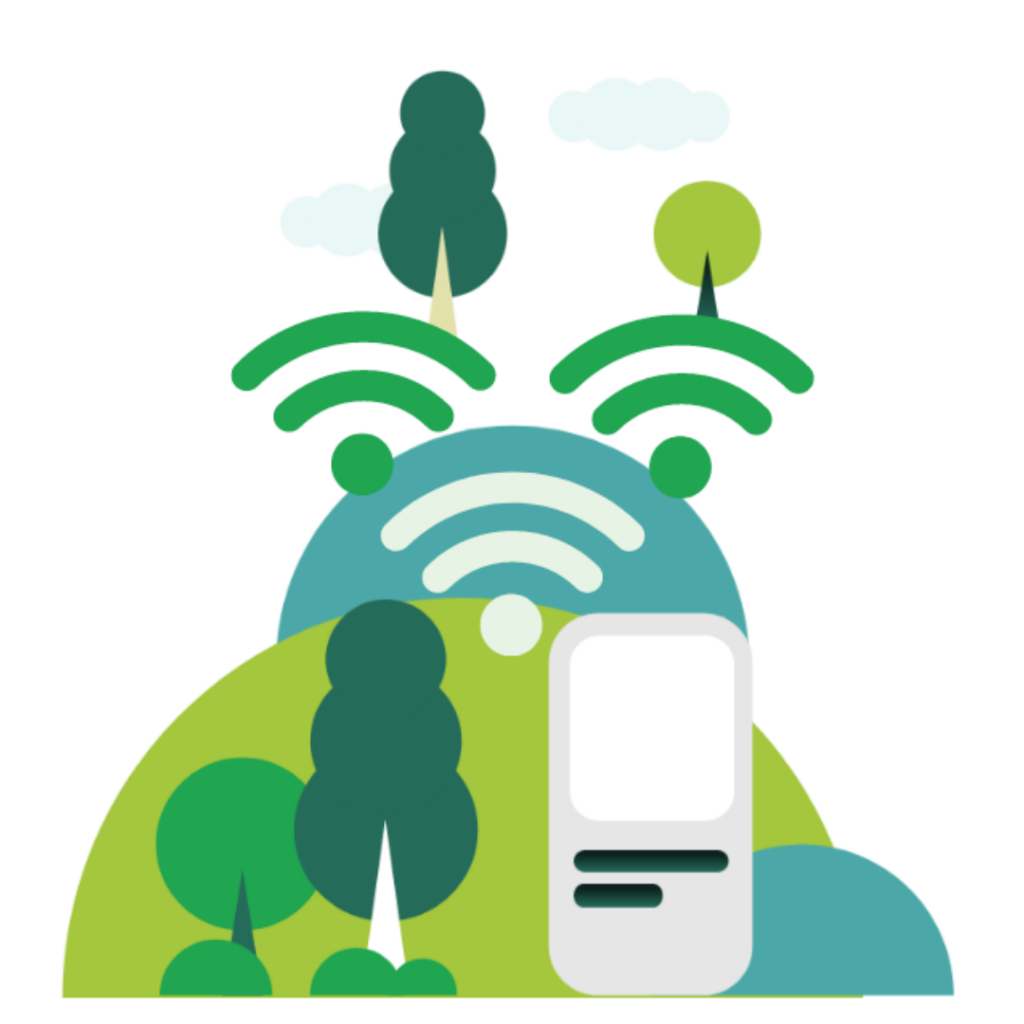The Internet has transformed and revolutionized modern-day society. Today, you can virtually access any piece of information you want, communicate and interact with people from the other side of the planet or perform daily work tasks without even having to leave your room.
But what about the impact it has caused to our habits?
Since the COVID-19 outbreak and consequential lockdowns, the total amount of our time spent on digital devices has risen exponentially, with 2021 being one of the highest years in terms of digital and Internet consumption. In fact, the “typical” global internet user now spends almost 7 hours per day using the Internet across all devices, according to the World Global Index.
As of 2022, the Web is used by approximately 5 billion people worldwide or 63% of the world population, producing large amounts of e-waste and CO2 emissions. The use of the Internet, social media and any online platform, emits a carbon footprint into the atmosphere.

What is Carbon Footprint?
Carbon Footprint is a measurement that expresses the amount of greenhouse gasses emissions that are generated during the lifetime of a product, service, organization, event or individual, usually expressed in tons of CO2 equivalent.
Internet has a Carbon Footprint too
Like all digital products, the Internet depends on large amounts of energy to function and be powered. Colossal databases and servers located in data centers – the Internet’s infrastructure – are used to maintain and preserve information that is directly presented on the World Wide Web. In other words, everything you see and do on the screen of your digital device. Every bit of information that you interact with, upload or create gets stored in these data centers which are made up of thousands of computers and servers. In fact, if the IT sector were a country, it would come in 3rd in terms of global energy demand behind the US and China (as stated in “Our Changing Climate”).

Sources of Internet Carbon Footprint
The main sources of the Internet Carbon Footprint are numerous. From its data centers located across the globe to streaming platforms, social media and even online gaming the Internet’s Carbon Footprint amounts to a staggering 1.6 billion annual tons of greenhouse gasses and is expected to increase by 2025.
The Internet’s “Infrastructure”
Compared to other CO2 producers such as cars, airplanes and manufacturing industries, the Internet’s emissions are seen as physically intangible, or ”hidden” to the general public. This is due to a lack of information regarding how and where the sources of energy are produced and come from. IT energy consumption is mainly due to large tech buildings known as data centers, where all the Internet’s hardware is located. In most countries, this means that the sources of energy that feed these infrastructures are non-renewable (i.e. fossil fuels), which ultimately explains the Internet’s substantial carbon footprint. According to Stolz and Jungblut (2019) the amount of energy required by all data centers worldwide, ranges from 200 to 500 billion kilowatt-hours per year, an estimated 1 to 3 percent of the world’s electricity. By 2030, the range is estimated to increase, between 200 billion and 3,000 billion kilowatt-hours (Reset).

The Data and IT industry are major players when discussing the Internet’s carbon footprint. Tech giants such as Google, Microsoft and Amazon are some of the major producers. Google, for example, runs 23 data centers across the globe, which requires high volumes of energy that produce large amounts of heat that can only be cooled down by billions of gallons of water and/or A/C units. This very same energy used for machine-cooling covers roughly 25% of the total emissions of the Internet (Times).
Videos, Audio and streaming websites
Streaming platforms such as Netflix and Youtube and other consumer-content channels like Twitch and Discord are responsible for roughly 60% of Internet traffic, greatly contributing to the Internet’s carbon footprint. In addition, the demand for high-definition streaming is rising, which is incentivising tech corporations to build further infrastructure in order to satisfy clientele.
Netflix claimed that one hour of streaming on its platform, in 2020, used approximately 100gm CO2 per hour (Wired), while Twitch used 33gms of CO2 per hour (Greenspector). Considering that users use streaming websites on a daily basis, it can mean a staggering amount of CO2. If not handled responsibly this will cause ulterior problems in terms of emissions.
Online Gaming
With technology and graphics advancing and lifelike gameplay perfecting itself in the last decade, the gaming industry has become one of the most lucrative sectors in the world. However, streaming games, downloading and storing them in the cloud along with direct online gameplay requires a lot of energy from servers, producing high amounts of Internet traffic. Although transferring video games in digital format can potentially be beneficial as it produces less physical e-waste (i.e plastic casing and CD production) the amount of energy used to maintain the online gaming industry can be immense. Depending on the location of the servers and data centers in which online games are being distributed, they can produce more or less CO2 based on the type of energy source they’re using.
Social Media
Social Media platforms such as Tik Tok, Whatsapp and Instagram – to name a few – are major contributors to the Internet’s traffic and the consequential digital carbon footprint. In a mere 60 seconds, Tik Tok gets downloaded 2704 times, Whatsapp shares 41.7 million messages and Instagram publishes 347,222 stories (Greenspector).
Posting a photo on Instagram for example, emits 0.15g of CO2, while scrolling your newsfeed for 1 minute emits 1.5g of CO2 (Earth). Considering that the average user in 2022, spends 2 hours and 24 minutes a day scrolling through various social media platforms (Greenspector.com), it can also contribute to a substantial build-up of the internet’s carbon footprint. So be mindful when taking a selfie.
You should be conscious of the Internet Carbon Footprint
In this article, we have seen in dept a huge amout of data about web pollution in order to better understand why the Internet emits CO2 and what the Web Carbon Footprint is. The digital demands for massive amounts of energy are a major issue when discussing digital sustainability. If we don’t start implementing sustainable and green policies that produce clean energy for the Internet, the only way to keep maintaining these levels of consumption is by using fossil fuels which is disastrous for the environment. To make the difference in our digital behaviour, we have collect 10 easy actions you can implement everyday to get a more sustainable online life: take a look at our Karma-Decalogue.
And the Companies that work online?
Companies are starting to become more aware of their digital carbon footprint. Netflix and Google are among some of the giant tech companies that have started to implement CO2-neutral website policies in their corporate culture, with the intent to make their business 100% green by 2030.
But, is this enough for the Internet to delete its carbon footprint and e-waste? Throughout a process of digital transformation in every industrial sector, companies need to face to carbon neutrality but also energy efficiency need.
How eco-sustainable is your webiste?
Sources:
- https://www.gwi.com/book-demo?utm_source=kepios&utm_medium=referral&utm_campaign=2021+Kepios+Global+Audiences
- https://datareportal.com/global-digital-overview#:~:text=A%20total%20of%205%20billion,12%20months%20to%20April%202022
- https://www.youtube.com/watch?v=Byl87SBFoo8
- https://en.reset.org/our-digital-carbon-footprint-environmental-impact-living-life-online-12272019/
- https://www.google.com/about/datacenters/locations/
- https://time.com/5814276/google-data-centers-water/
- https://tree-nation.com/it/progetti/inside-tree-nation/articolo/11923-the-carbon-footprint-of-the-internet-the-emissions-of
- https://www.wired.co.uk/article/netflix-carbon-footprint#:~:text=Using%20a%20tool%20called%20DIMPACT,a%20quarter%20of%20a%20mile.
- https://greenspector.com/en/category/applications-sobriety/?fbclid=IwAR1KrVnZ5W0l4TkIAInzSxDe8HE64lcPw1mDuZn_LWXShUTyV4CYdR25OWs
- https://earth.org/how-social-media-habits-are-contributing-to-internet-pollution/#:~:text=This%20might%20not%20seem%20like,media%20accounts%20and%20streaming%20platforms.
- https://about.netflix.com/en/news/net-zero-nature-our-climate-commitment
- https://sustainability.google/commitments/
- https://www.bbc.com/future/article/20200305-why-your-internet-habits-are-not-as-clean-as-you-think





